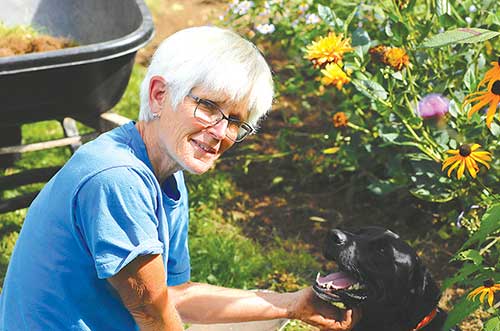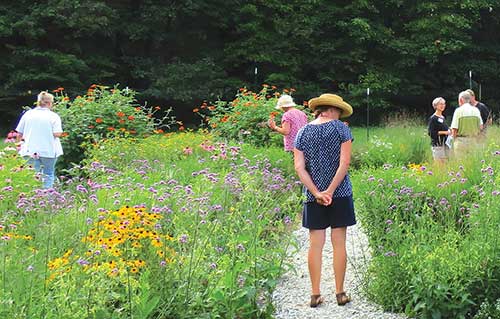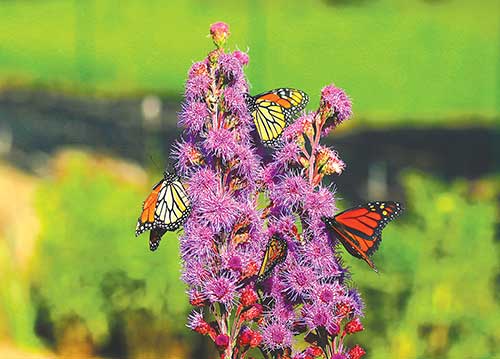 |
| Barbara Murphy with her dog, Marley, in the pollinator garden. Photo courtesy of Barbara Murphy |
 |
| Visitors enjoy the garden during the 30th anniversary celebration of Mahoosuc Land Trust. Photo courtesy of Barbara Murphy |
 |
| Liatris (blazing star) attracts monarch butterflies. Photo by Mike Murphy |
By Joyce White
We’ve all heard of the decline of honeybees, one of the chief pollinators of plants. According to the University of Maryland, U.S. beekeepers lost more than 40% of their honeybee colonies between April 2018 and April 2019, and wild bee populations are also declining. Other species, including wasps, bumblebees, some flies, moths and butterflies, do help with pollination, but honeybees pollinate about 35% of the world’s food crops, according to the USDA Natural Resources Conservation Service.
From an Appalachian Mountain Club magazine, a beekeeper friend learned that the rusty patched bumblebee, useful in pollinating blueberries and tomatoes, is now found in only 12 states, including Maine, but was once in 28 states.
What to do? Albert Einstein said, “The world we have made as a result of the level of thinking we have done thus far creates problems that we cannot solve at the same level at which we have created them … We shall require a substantially new manner of thinking if mankind is to survive.”
He also said, in another context, “Any intelligent fool can make things bigger, more complex, and more violent. It takes a touch of genius – and a lot of courage – to move in the opposite direction.”
Barbara Murphy, development director at Mahoosuc Land Trust in Bethel, has been moving in that opposite direction. She started planning a basic, down-to-earth garden to attract pollinators soon after she was hired by the land trust in 2017.
My contacts with Murphy in the 20-plus years since I’ve lived in Stoneham, Maine, have always related to gardens, through classes she taught at the Oxford County Cooperative Extension office, lush gardens she established in a previously unused space outside that office, new community gardens she established in South Paris, and gardens and greenhouses she and her husband, Mike, have created at their home.
All change starts with a big idea, she believes, and one of her big ideas is that “better is better,” that small steps add up to a big impact. So Murphy got to work right away on the idea and process of creating a 10,000-square-foot pollinator garden on the grounds of the Valentine Farm, home of Mahoosuc Land Trust.
An amazingly energetic and creative teacher, gardener and organizer, Murphy is also expert in drawing a team of volunteers into gardening projects with her enthusiasm and her willingness to work even harder than the volunteers. Her husband volunteered his knowledge and expertise in planning the selection and placement of plants. Except for what I have read of plant experts such as Luther Burbank and Alexander Humboldt, Mike Murphy knows more about plants, including rare and exotic ones, than anyone I know.
Gardens and land trusts go together, Barbara Murphy believes, and can arouse people of all ages to an interest in nature and the environment. Land chosen to be within walking distance of the new land trust building at Valentine Farm presented a challenge because its abundant gravel and stone made digging difficult. The first year, the gardeners added compost to a small nursery area where over 1,000 plants were tightly spaced to grow out and safely overwinter. The rest of the future garden area was covered with landscape fabric until the following late spring to kill grasses and weeds and to soften the ground.
The garden had plenty of quackgrass, a terrible perennial weed. The gardeners removed it by hand, carefully; otherwise, any piece left behind will grow another plant. It takes a village, says Murphy, to carry out big ideas.
That first year was incredibly hot, requiring hours of hand watering. The dedicated volunteers really rose to the challenge, Murphy added. Thanks to a grant from the Quimby Family Foundation, hoses and a pump now bring water from the Androscoggin River, making watering much easier.
Murphy taught classes about growing flowering plants known to attract pollinators, and the classes themselves attracted many enthusiastic volunteers. For the pollinator garden, the gardeners chose drought-tolerant, pollinator-friendly plants to provide blooms from early summer to late fall.
More than 50 types of perennials, including grasses, populate the garden along with a handful of annuals. They include foxglove, Joe Pye weed, anise hyssop, three kinds of coneflower, two kinds of aster, three of blazing stars, black-eyed Susan, white wand beardtongue, cup plant, heart-leafed meadow parsnip, wild quinine and feather reed grass. Annuals add diverse colors and structures, and their long bloom periods keep the garden in flower between bursts of perennial blossoms. The plants are arranged in clusters for efficient feeding and easy recognition by visiting insects.
One of Murphy’s favorite plants in the garden is Mexican sunflower, Tithonia rotundifolia. This orange, carefree pollinator magnet likes full sun, and it blooms from August until frost.
In 2020 the gardeners plan to add over a dozen more perennials as well as a variety of culinary herbs that, when in flower, attract a wide range of insects. Some of the plants are larval food for swallowtail butterflies. The garden is a work in progress and will continue to grow, probably doubling in size ultimately. Some plants inevitably die out, and new ones are added. Some spaces have been left open for additions as well as for ground-nesting bees.
As part of a citizen science initiative, the garden participates in Monarch Watch (https;//www.monarchwatch.org). Volunteers tag monarchs in late summer and fall, before they migrate to Mexico. Other volunteers report the tagged butterflies they find in Mexico. Researchers use this information to better understand migration and survival rates of these migrating jewels.
The garden is also part of the Million Pollinator Challenge (millionpollinatorgardens.org) and will be promoting Pollinator Pathways (pollinator-pathway.org) to homeowners in 2020 as a way for everyone to be involved.
Bonnie Pooley, long-term Mahoosuc Land Trust director, commented, “On a warm summer day, it is breathtakingly beautiful, both the sight of blossoming plants and also the loud buzzing of many pollinators flying from flower to flower. The garden is a place of refuge for humans and insects alike.” Murphy says that gardening can give us purpose and bring us together.
Visitors and volunteers are welcome in the garden at Mahoosuc Land Trust, 162 North Rd., P.O. Box 981, Bethel, Maine 04217 (207-824-3806; [email protected]; www.mahoosuc.org).
About the author: Joyce White is has written feature stories for The MOF&G for many years.
